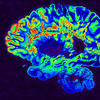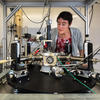You are here
Downloading the human mind

Mickey 17 depicts the downloading of a person’s mind into other bodies. In theory, how could this be possible?
Gregor Thut1: The neural circuits of at least three major important functions would have to be reproduced in order to recreate a person’s identity and sense of self: memory, which enables us to store and recall what we have experienced and learned over the course of our lives; consciousness, which makes us aware of ourselves and our environment; and the feeling of being at one with our bodies, which is essential to the sense of self.
What do we know about the physical mechanisms of human memory?
G. T.: As with all of our other cognitive abilities, this function arises from a number of extensive neural networks in the brain. But it’s important to note that there isn’t just one memory but several. Some are what we call short-term, allowing information to be retained over short time periods, ranging from a few seconds to several minutes. Others are long-term and keep a record of data over longer durations, spanning an entire lifetime.
The latter would be the most important for recreating a person’s identity. They include episodic or autobiographical memory, which contains personal recollections, as well as procedural or motor memory, which stores skills and reflexes acquired in life, such as driving a car, riding a bicycle or playing the guitar.

Each of these memories involves different neural circuits and regions of the brain. At the neuronal level, information is stored by the development of new connections between neurons, known as synapses, or the reinforcement of existing ones.
What about consciousness?
G. T.: According to a prevailing theory, known as the ‘global neuronal workspace’, consciousness arises from a global connection among several sections of the brain, located in the frontal and posterior regions. This network is believed to enable us to be aware of ourselves and our environment, by making information from our senses – initially processed at an unconscious level – available to all of our mental faculties, including attention, memory and reasoning.
And where does the sensation of being one with our bodies come from?
G. T.: From the coherent integration of various sensory signals that provide information on the position of our body in space. This information comes from three systems: the visual system; the vestibular system, i.e. the balance mechanism of the inner ear; and the proprioceptive system, comprising all of the receptors and their innervation in the muscles and joints, which regulates posture and body movements. If these sensory signals are not coherent, as in the case of disorganised cerebral activity, the brain may conclude that we have left our bodies.
Do you believe that it will be possible one day to export these three functions and thus transplant a person’s mind into another body, as depicted in Mickey 17?
G. T.: I think it would be very difficult… Cloning each of these three functions would be a daunting challenge, especially because we are far from having thoroughly deciphered all the underlying processes. For example, for long-term memory we would need to know the neural and synaptic signature of each memory and bit of learning being stored – a real conundrum!
Specifically regarding the possibility of obtaining consciousness in an artificial neural network, this is now an important topic of debate in connection with the development of artificial intelligence. Brilliant specialists are pondering the question. But the possibility of generating consciousness from artificial neural networks remains controversial, since consciousness is such a complex faculty… In short, at this point in time the possibility of transplanting a mind into a different body remains the stuff of science fiction.
What are your thoughts on the idea of implanting a human mind into a new ‘recipient’ body?
G. T.: It raises a serious ethical question: is it really a good thing to download our memories into another body or an artificial medium like a robot? In fact, the prospect ventures into the realm of transhumanism, an ideology based on the idea of using science and new technologies to improve or increase our physical and mental capacities, thus extending life expectancy and perhaps even making us immortal. But is immortality really so desirable? After all, we might not enjoy an eternal life as much as a life that we know will end one day…

Secondly, being able to completely decode and transplant our minds into other media could pose several risks. First of all, it could expose us to the threat of intrusion into our thoughts and therefore into the private sphere of our mental life.
Finally, such a technology could enable the reproduction of an individual’s mind while they are still alive, and thus the creation of several duplicates, causing that person to lose their identity. Indeed, it would be tantamount to cloning a personal identity. Which one would then be the original? I think it’s better to leave the whole idea within the confines of good science fiction movies – like Mickey 17! ♦
For viewing
Mickey 17, by Bong Joon-ho, in French theatres since 5 March, 2025.
- 1. CNRS research professor at the Brain and Cognition Research Centre (CerCo – CNRS / Université de Toulouse).
Explore more
Author
A freelance science journalist for ten years, Kheira Bettayeb specializes in the fields of medicine, biology, neuroscience, zoology, astronomy, physics and technology. She writes primarily for prominent national (France) magazines.
















